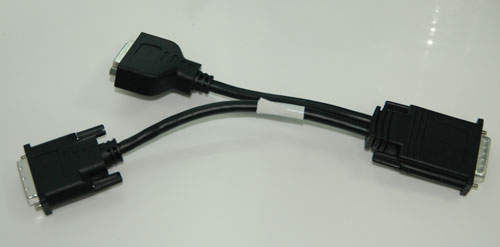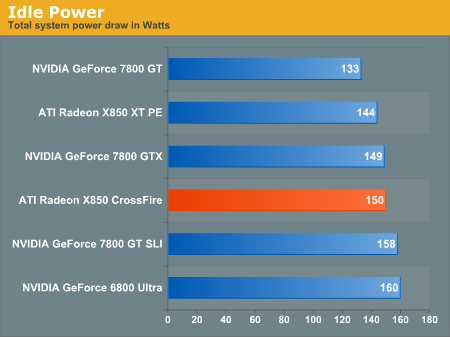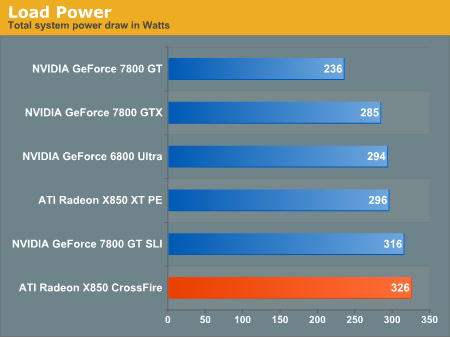ATI's X8xx CrossFire Graphics Arrive
by Derek Wilson on September 26, 2005 1:00 PM EST- Posted in
- GPUs
Hardware and Power
The components that go into a CrossFire system consist of the CrossFire master card, a slave card, a CrossFire dongle, and a motherboard with more than 1 PCI Express x16 slot. Here's the run down of our test system:AMD Athlon 64 FX-55
ATI Radeon Xpress 200 CrossFire motherboard
1GB DDR400 2:2:2:8 RAM
120GB Seagate 7200.7 HD
OCZ Powerstream 600W PSU
The CrossFire master card is basically an X850 XT with the addition of a Xilinx FPGA (for the compositing engine) and a TMDS receiver for taking input from the slave card. Instead of 2 DVI-D ports, the CrossFire master card makes use of a high speed DMS port. This connects to one port of the CrossFire dongle and takes the slave card input as well as providing the output to the monitor.

Other than that, the CrossFire card looks just like any other X850 XT out there.

The CrossFire design is fundamentally different than NVIDIA's SLI. CrossFire uses an external compositing engine while NVIDIA's is built into the GPU. ATI handles communication via TMDS output from the slave card's framebuffer, while NVIDIA built a chip to chip communications protocol for multi-GPU operation. Both vendors offer extended antialiasing modes, but ATI offers an additional rendering mode called SuperTiling which cuts each scene up into a checkerboard pattern for rendering.
On both solutions, Alternate Frame Rendering (AFR) is the fastest mode, as this is the only mode that also accelerates geometry processing. In order to learn more about the details of how CrossFire works, please check out our previous article on the subject.
As for the stress all this hardware puts on a system when it's in action, here's a comparisons of idle and load power (under Splinter Cell: Chaos Theory). Power is measured at the wall before the PSU.


While the idle power draw is slightly lower than 7800 GT SLI, the load power is the highest of any of the measured setups. 7800 GTX SLI would be higher still, but X850 XT PE Crossfire is really closer to the 6800 Ultra SLI or 7800 GT SLI, so it's not a fair comparison. We'll have to wait for R5xx and Crossfire before we can get a good idea of how Crossfire competes with 7800 GTX SLI.










76 Comments
View All Comments
DerekWilson - Tuesday, September 27, 2005 - link
Actually, we took our time. Copied a few numbers down incorrectly. Sorry about that.Googer - Monday, September 26, 2005 - link
Why hasn't anyone tested these on an nForec 4 motherboard yet? ATL Crossfire on a DFI SLI motherboard, will it work?OvErHeAtInG - Monday, September 26, 2005 - link
Um, no. In the future, with different drivers? Who knows. But nvidia is unlikely to provide good nF4 drivers for people who are buying ATI cards?Live - Monday, September 26, 2005 - link
How is the total power draw calculated, before or after the PSU?DerekWilson - Monday, September 26, 2005 - link
Sorry I didn't explain -- I'll add the infopower draw is measured before the PSU -- so yes, the dissipated power of the supply itself is included. And I do know that power draw at the wall is not exactly linear with respect to power supplied to the computer. At the same time, watts pulled from the wall are what we pay for right? :-)
Dangher - Monday, September 26, 2005 - link
You do realise that without proper homework you are just perpetuating sensationalism, right? The TMDS receiver has nothing to do with actual framerate or screen refresh, you do know that, right? You are aware that 1600x1200@60Hz in the TMDS translates into about 2500x1500@100Hz when doing SLI (or Crossfire, as is the case), right? Now go do your homework and correct the article (you're liable to be sued for libel by ATI btw).overclockingoodness - Monday, September 26, 2005 - link
LOL, you are such an idiot. AnandTech can't be sued for libel; did you ever take business 101? Apparently not. Please keep your mouth shut on the things you have no clue about.DerekWilson - Monday, September 26, 2005 - link
sorry m8, don't know where you got your info, but regaurdless of the fact that it is possible for the output to be run at a higher resolution than the TMDS receiver doesn't matter when the product manager of CrossFire at ATI states that the output of CrossFire will be locked to 1600x1200@60Hz *because* of the single link TMDS receiver.I'm sorry if I didn't make it completely clear that ATI could decouple their output from the reciever but they have chosen not to.
Pete - Monday, September 26, 2005 - link
The TDMS receiver is specced to the TDMS transmitter on the slave card, so it is indirectly tied to the screen refresh. I don't recall Derek saying it limits the frame rate, but obviously you can't see more frames than screen updates, so it can potentially limit the visible framerate, too. Yes, that applies to anything with a different frame than refresh rate, but XFire is fairly limited at 16x12@60Hz.And, no, you don't double up TDMS rates with XF, as the CE (Compositing Engine) doesn't have a buffer to accomodate a refresh rate independent of TDMS rate (which is, again, limited to 16x12@60Hz).
Dangher - Monday, September 26, 2005 - link
It is late and I can't be bothered to look for the techie article on this particular problem and why it's been blown out of proportion, but I will do it tomorrow and post a link here. My apologies to Derek if I offended him, it really is late. Link upcoming.